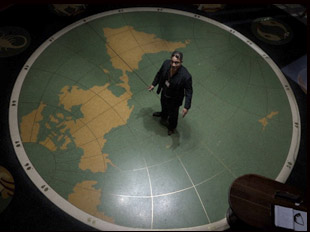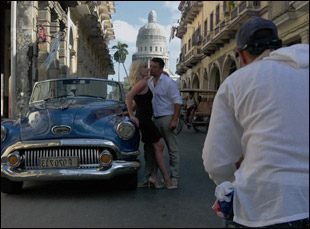Hubert Sauper had already been filming in Cuba when Fidel Castro died in the fall of 2016, an event that gave him pause when the passing of the man who had been so central to the country’s identity for a past half-century might mean radically reconceiving his film. Instead, the fact that little had change gave him more confidence in what he was working on with “Epicentro” when that change had already happened so long over time it had become largely imperceptible.
“I thought that once Fidel died, things would radically change, which was not the case,” says Sauper. “I was anticipating more of an external change that I would then document in my film, but I found a more internalized study about history and about moving images.”
Sauper has become the preeminent documentarian to bring stories of modern-day colonialism to the screen, last trekking to Sudan to see various international interests arrive to exploit the country’s oil supply for “We Come as Friends” and previously embedding in Tanzania to see the havoc wreaked by Russians and Ukrainians as their fishing practices leave Lake Victoria with practically nothing for the locals to eat. While the filmmaker is always careful to show the subtle effects that a wealthy country’s pillaging has on a less prosperous one, “Epicentro” deals with costs that are rarely calculated, but so exposed as to make people lose sight of them in showing the soft power of images from Cuba, first produced professionally by Americans to convince those abroad they were waging a righteous battle with the Spanish-American War that commenced with the sinking of the U.S.S. Maine at the Port of Havana leading to the trade blockade, and later as Cuba opened up to tourists, whose wealth has not yet been redistributed throughout the country, but are eager to take back pictures of a place that remains frozen in time.
Following a group of children as they take in early films such as George Méliès’ “A Trip to the Moon” as if they were as spellbound as the very first audiences to see it in 1902, “Epicentro” draws a unique contrast between a culture that isn’t as conscious of how images are constructed yet whose own image has been shaped so profoundly by others throughout the years. Sauper may blow the kids’ minds by introducing them to Oona Chaplin, the granddaughter of the silent comedian whose films they come to love so much, but for audiences outside of Havana, the film has a similar effect in revealing a place different than what the popular view has shown with the filmmaker actively interrogating his own responsibility in projecting images out to the rest of the world. The winner of this year’s Grand Jury Prize for Documentary in the World Cinema section, “Epicentro” is now making its way across the world with a release in virtual cinemas and while in France, Sauper spoke about what drew him to film in Cuba, his ongoing interest in how images travel and the creeping Western influence on Cuban culture.

I wanted to make a piece about the term dystopia, and about narrative and moving images, and it all led to Cuba. As you see in the movie, it’s an epicenter of the planet in many ways, and I was really fascinated by the fact that few societies on the planet have such a specific culture of thinking about geopolitics and the context in the world. People in general are very politicized in Havana, even though they [know of] one narrative, which is the narrative of the Revolution.
But it’s not a film about Cuba. It’s set in Cuba, but these themes are almost anywhere in the world and it’s a global story. It’s something that touches every human being almost because moving images are the way we communicate nowadays more than anything else. The origin of that was literally the big bang in the Port of Havana, the event where America wants to go to war and they needed a powerful tool to convince [the masses with] the message that we have to go to the Caribbean, so the more I was researching, the more I was learning of [this epicenter of Cuba] which is really literally ground zero for many things.
Your films have long grappled with the responsibility of imagery, but this seems like it may be the most direct when it incorporates the history of cinema. Had it been something you want to take head on?
I always try to understand or try to figure out what it might’ve been like for people 120 years ago to see for the first time a moving photograph. It must’ve blown people’s minds. [And now] somewhere in the world, suddenly we’ll have a hologram of Nelson Mandela having a beer with us or something, and it’s crazy you know? So it’s pure fascination, but still powerful that anything in a moving image would be taken for granted. The landing on the moon, Apollo 11, was anticipated 70 years before before by the filmmaker [George Méliès in “A Trip to the Moon”] — the exact destination, it was almost a blueprint, so that was really fascinating to me and [over a career, it] takes a lot more than one movie to cause reflection.

This guy was just an archetype of many people who go to foreign lands to take something, and in that case, it was to take images and go. That’s what I do as a filmmaker, but I have different thinking and more time to reflect on it and to make a connection with the people that I photograph. That person who was being photographed by me was just one of many tourists who take Old Havana as like a firing ground where you literally shoot everything you see, and it’s interesting this person could’ve also been in the Serengeti in Africa, firing at a giraffe, so it is an aspect of colonialism. Colonizers always go to foreign lands to come back with paintings with drawings, with knowledge. Napoleon sent out his soldiers to Egypt to get cooks, architects and builders and military philosophers to learn how the Egyptians build and cook, so it’s an old story. Nowadays going to foreign lands and taking pictures is an act of colonialism in a way. It’s unthinkable for us to be in your home and someone just opens the door and starts taking pictures. You don’t think of it, right?
You see the invasion beyond that when you end up at this luxury hotel where the kids visit the pool. Was that hotel in development while you were there?
It’s interesting [because] when you write a script for a documentary, you write scenes that might happen [to] describe people to get the money [to finance the film], and the end of my script was a dystopian end. Like a vision of Trump Tower on the shore of Havana, which did not happen – at least not yet. But then I Googled Trump Tower in Havana and found out later after I had written that vision of horror in my script, Trump actually did have a plan already to make a tower in Havana.
[The hotel scene] was one of these days where we were hanging out with the kids and they wanted to go to the pool. The reason why they wanted to go to the pool was because they are seeing the Western propaganda — they are looking at the pictures on Facebook where the movie stars are hanging out by the pool. Then one aspect of the Cuban revolution is this obedience to power and to authority or political authority, so to crash and [get in the pool] is this radical act. I liked it because it reminds you of what life should be. It’s a very liberating moment, [and given what happens] for me in the moment, I’m still laughing. I just thought it was so funny to be in the pool.
Oona Chaplin is an old friend and I had shown her some footage of the kids that I had edited and she fell in love with the kids. She came to Cuba and I introduced them to each other and that was it.
One of the children, Leoneli, seems like a real star as well, and at one point in the film she mentions she wants to be an actress. Did you realize in some way you were making a dream come true?
I found her at the very second you see in the movie, when you see a bunch of children [in one place at once] and they all hear the story of Cuba, and she’s talking about “Thanks to Fidel, now we have schools.” She was so charismatic and so outstanding in her appearance that I thought [I had to follow her]. And she says, “I want to go to Paris one day,” and she is literally all over Paris at this very moment in posters. [laughs] Her image is on the posters – it’s on the subway and in the metro, so it’s somewhat absurd that she cannot be here [because of COVID-19 travel restrictions] — of course, I would’ve given her money to fly her in to see her celebrated for what she is, but she’s everywhere.
“Epicentro” is now playing in virtual cinemas, supporting your local arthouse theater. A full list is here.




